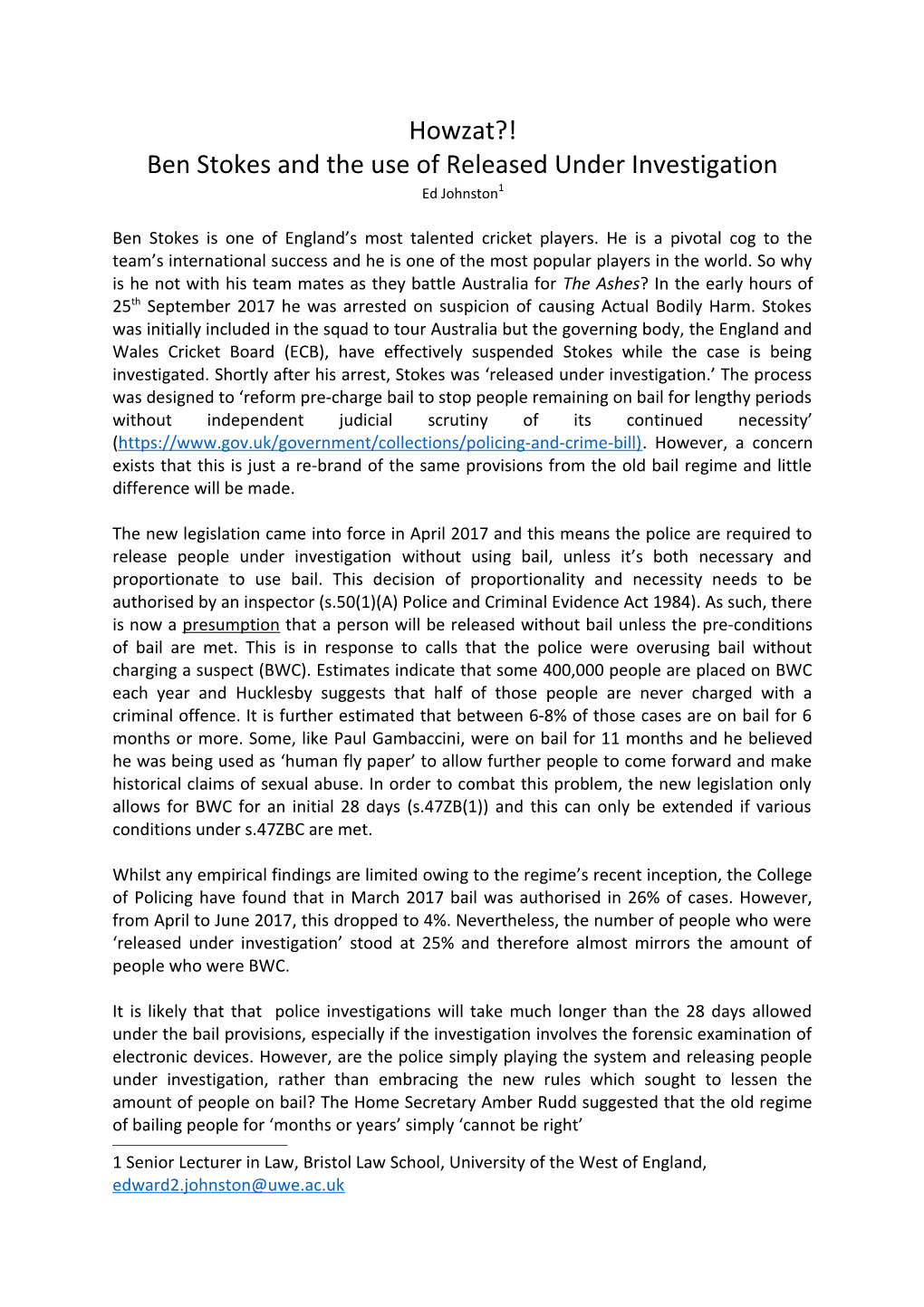Howzat?!
Ben Stokes and the use of Released Under Investigation
Ed Johnston[1]
Ben Stokes is one of England’s most talented cricket players. He is a pivotal cog to the team’s international success and he is one of the most popular players in the world. So why is he not with his team mates as they battle Australia for The Ashes? In the early hours of 25th September 2017 he was arrested on suspicion of causing Actual Bodily Harm. Stokes was initially included in the squad to tour Australia but the governing body, the England and Wales Cricket Board (ECB), have effectively suspended Stokes while the case is being investigated. Shortly after his arrest, Stokes was ‘released under investigation.’ The process was designed to ‘reform pre-charge bail to stop people remaining on bail for lengthy periods without independent judicial scrutiny of its continued necessity’ ( However, a concern exists that this is just a re-brand of the same provisions from the old bail regime and little difference will be made.
The new legislation came into force in April 2017 and this means the police are required to release people under investigation without using bail, unless it’s both necessary and proportionate to use bail. This decision of proportionality and necessity needs to be authorised by an inspector(s.50(1)(A) Police and Criminal Evidence Act 1984). As such, there is now a presumption that a person will be released without bail unless the pre-conditions of bail are met. This is in response to calls that the police were overusing bail without charging a suspect (BWC). Estimates indicate that some 400,000 people are placed on BWC each year and Hucklesby suggests that halfof those people are never charged with a criminal offence. It is further estimated that between 6-8% of those cases are on bail for 6 months or more. Some, like Paul Gambaccini, were on bail for 11 months and he believed he was being used as ‘human fly paper’ to allow further people to come forward and make historical claims of sexual abuse. In order to combat this problem, the new legislation only allows for BWC for an initial 28 days (s.47ZB(1)) and this can only be extended if various conditions under s.47ZBC are met.
Whilst any empirical findings are limited owing to the regime’s recent inception, the College of Policing have found that in March 2017 bail was authorised in 26% of cases. However, from April to June 2017, this dropped to 4%. Nevertheless, the number of people who were ‘released under investigation’ stood at 25% and therefore almost mirrors the amount of people who were BWC.
It is likely that that police investigations will take much longer than the 28 days allowed under the bail provisions, especially if the investigation involves the forensic examination of electronic devices. However, are the police simply playing the system and releasing people under investigation, rather than embracing the new rules which sought to lessen the amount of people on bail? The Home Secretary Amber Rudd suggested that the old regime of bailing people for ‘months or years’ simply ‘cannot be right’
( ). Yet, the initial statistics from the College of Policing suggest that very little has changed.
If the police no longer have fixed deadlines to meet as bail was going to expire, is there a danger that investigations will take even longer than before? Those who are RUI could languish for longer periods of time without an end date in sight. Take Stokes for example; he is arguably missing out on the pinnacle of a Test Cricketer’s career because a decision to charge is yet to materialise some 65 days after he was released. At face value, the case is not complicated, there are witnesses, good quality CCTV footage of the alleged assault and the suspects were identified and arrested at the scene. Yet nearly 3 months later, Stokes is effectively suspended from work, causinguncertainty about his international future and earning potential in other formats of cricket. Furthermore, both the victims and witness are left in a state of limbo of not knowing if they will be required to give evidence at what would no doubt be a high profile trial.
Releasing somone under investigation has emerged as an operational response to managing large numbers of suspect. The intention behind the process might be sound i.e.to reduce the number of people on bail, reducing uncertaintyand bring about much needed safeguards and independent scrutiny. However, a danger exists that the regime has done the opposite. David Tucker, the Crime Lead at the College of Policing stated that the ‘new legislation is a significant change for policing and has sought to strike a balance between the need for police to manage investigations and not leaving a person suspected of crime on bail for an unacceptably long period.’ Stokes is a likely to be the highest profile person currently RUI and at the time of writing (27th Nov), he has flown to New Zealand in the hope of joining up with his teammates very shortly. Coincidentally, on 29thNovember, Avon and Somerset Police handed all the evidence to the CPS so they can offer advice on a charging decision. Whilst, this move may be merely coincidental, one suspects that a person with a lower profile would not benefit from such a coincidence; despite the fact, they may be suspended from work, facing an uncertain future and simply waiting for the police to complete their investigation as they remain in criminal jusitice purgatory.
[1] Senior Lecturer in Law, Bristol Law School, University of the West of England,
